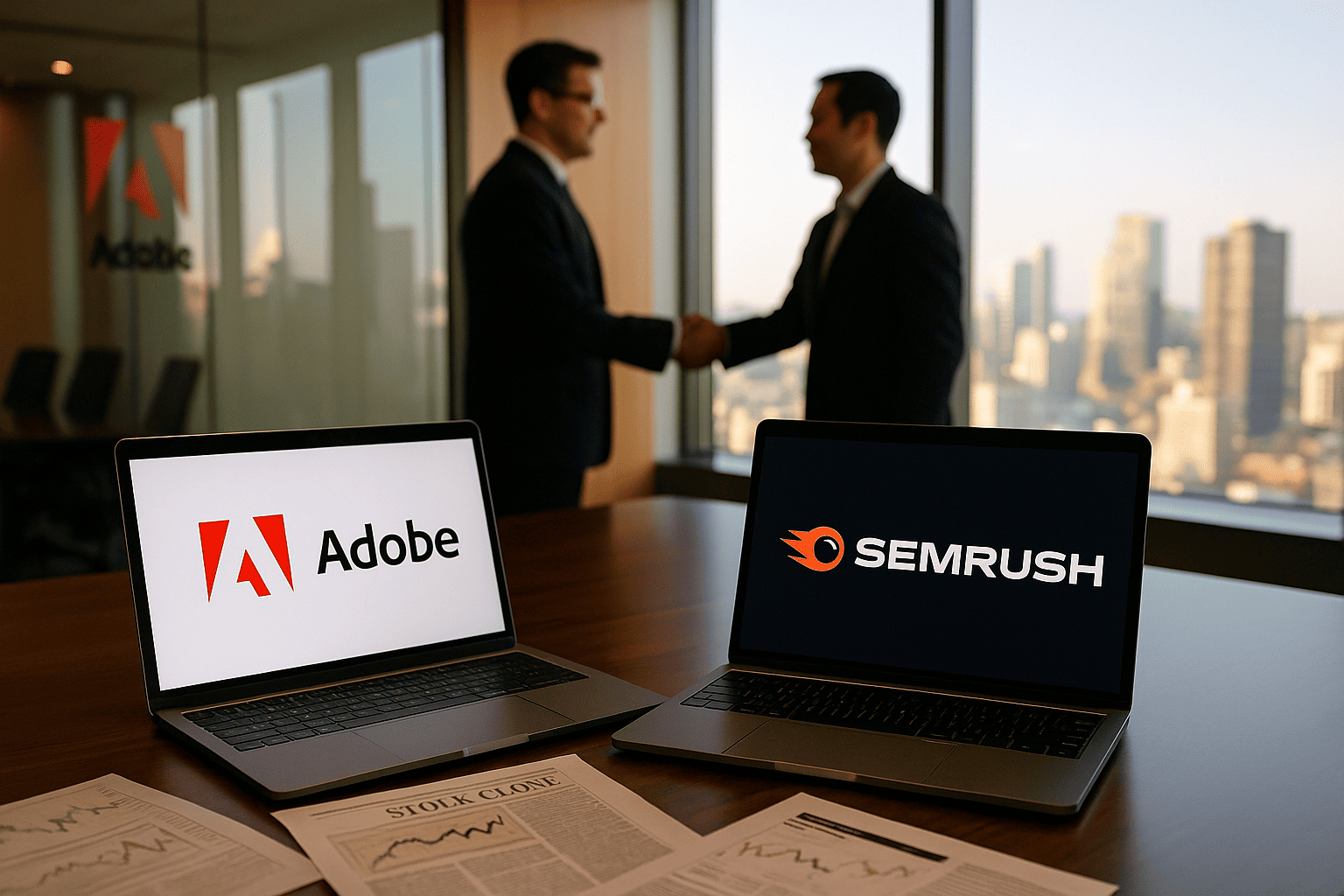Adobe Nears $1.9B Semrush Buy to Boost AI Marketing Stack
By Tredu.com • 11/19/2025
Tredu

What is being reported
Adobe is close to acquiring Semrush for about $1.9 billion, with a proposed $12 per share price that implies a premium near 77.5% to Tuesday’s close, according to the Wall Street Journal and a Reuters readout that cited the Journal. Shares of Semrush jumped in premarket trading after the report. The parties have not commented, and talks could still fall through.
Strategic rationale, in plain terms
Semrush brings search engine optimization, paid ads insights, traffic analytics, and competitive intelligence that thousands of marketers use daily. Folding those tools into Adobe’s Experience Cloud and analytics portfolio would give customers a tighter loop from content design to distribution to measurement. The move complements Adobe’s push to monetize AI across creative and marketing workflows, a theme the company has emphasized through 2025 guidance updates and product releases.
Price, premium, and how investors might read it
At $12 per share, the label sits well above recent trading levels, which is why premarket gains were large. For Adobe, a $1.9 billion ticket is digestible against a market capitalization above $100 billion and annual revenue in the mid-twenties billions. Investors will ask two questions: does Semrush lift Adobe’s net retention by deepening adoption across marketers; does the asset accelerate AI driven features that increase attach rates for analytics and ad tech. If the answers are positive, a premium can be justified by cross sell and lower churn.
Positioning relative to past deal practice
The company has a history of using acquisitions to fill capability gaps. Its attempt to buy Figma faced heavy antitrust scrutiny in Europe and the UK, which ultimately led to termination. A Semrush deal is smaller, focused on marketing data and workflow rather than a direct rival to core design software, which may reduce regulatory friction, although data and ad analytics remain sensitive categories. Authorities would examine market shares in SEO, paid search tooling, and web analytics, plus data access conditions for rivals.
How Semrush could slot into Adobe’s stack
Integration could follow three tracks. First, API level connections that surface Semrush keyword and competitive data inside Adobe Analytics and Workfront, so planning and measurement live in one view. Second, content feedback loops where creative teams in Photoshop, Illustrator, or Express see audience and search signals before publishing. Third, AI features that learn from performance data, then suggest layout, copy, or channel mix. The aim is a closed loop that shortens the path from concept to conversion.
Financial contours to watch
If announced, expect Adobe to frame the deal as accretive to growth and neutral to modestly dilutive to non-GAAP margins in year one, given integration and retention costs. Revenue synergy would rely on packaging Semrush tiers with Adobe enterprise bundles and on pushing higher priced analytics seats. Cost synergy would come from consolidating infrastructure, sales coverage, and support. Investors will look for milestones, for example an updated bookings target for Experience Cloud that embeds Semrush contribution.
Market context this year
Adobe shares have been volatile as investors debated the speed of AI monetization. The firm raised its fiscal 2025 outlook in September, citing firmer demand for design software and early traction for AI features, yet the stock is still down year to date, which keeps pressure on management to show tangible ARR from new bets. A credible Semrush tie-in could help the narrative by anchoring AI features in measurable marketing outcomes rather than only creative productivity.
Competitive implications
For customers that use point solutions, consolidation inside Adobe reduces vendor sprawl and sign-on friction. For rivals in SEO and ads tooling, a successful integration would raise the bar on breadth, since Adobe can combine creative assets, audience segments, and search insights in one paid relationship. Cloud platforms with marketing suites may respond with partnerships, for instance deeper integrations with independent SEO tools, to preserve optionality for clients.
Regulatory and data considerations
Even at a smaller deal size, data governance will be central. Regulators may ask how Adobe will silo, anonymize, or aggregate search and traffic data so that customers retain control and competitors are not foreclosed. Clear interoperability commitments could reduce concerns. Lessons from the Figma review, different domain yet instructive, suggest that early engagement with EU and UK authorities and transparent product roadmaps matter.
Execution risks
Closing risk is the first hurdle, given that the companies have not confirmed an agreement. Post-close, the work shifts to customer migration, pricing, and sales enablement. Bundling that feels like a tax can trigger churn; bundling that removes pain points tends to lift retention. Integration pace must balance speed with reliability, since marketers plan quarterly campaigns and cannot tolerate tool instability.
Potential market impact if confirmed
Adobe gains a clearer data spine for its marketing suite, which could support higher attach and steadier ARR. Independent SEO and ads platforms may see pressure, although open ecosystems can offset that with partner depth. For investors, the focus will be on whether Adobe can translate the acquisition into faster Experience Cloud growth and on how quickly AI features tied to Semrush data show up in customer metrics. If regulators ask for behavioral remedies, the timing of cross-sell could slip; if the review is light, integration can move faster.
Bottom line
A Semrush purchase near $1.9 billion at $12 per share would give Adobe more first-party marketing intelligence and a tighter bridge between creative, distribution, and measurement. The strategy is consistent with a push to prove AI value in concrete outcomes, not only in creative speed. The next signals are simple, a formal announcement, early regulatory readouts, and integration milestones that map to ARR and retention.

How to Trade Like a Pro
Unlock the secrets of professional trading with our comprehensive guide. Discover proven strategies, risk management techniques, and market insights that will help you navigate the financial markets confidently and successfully.


